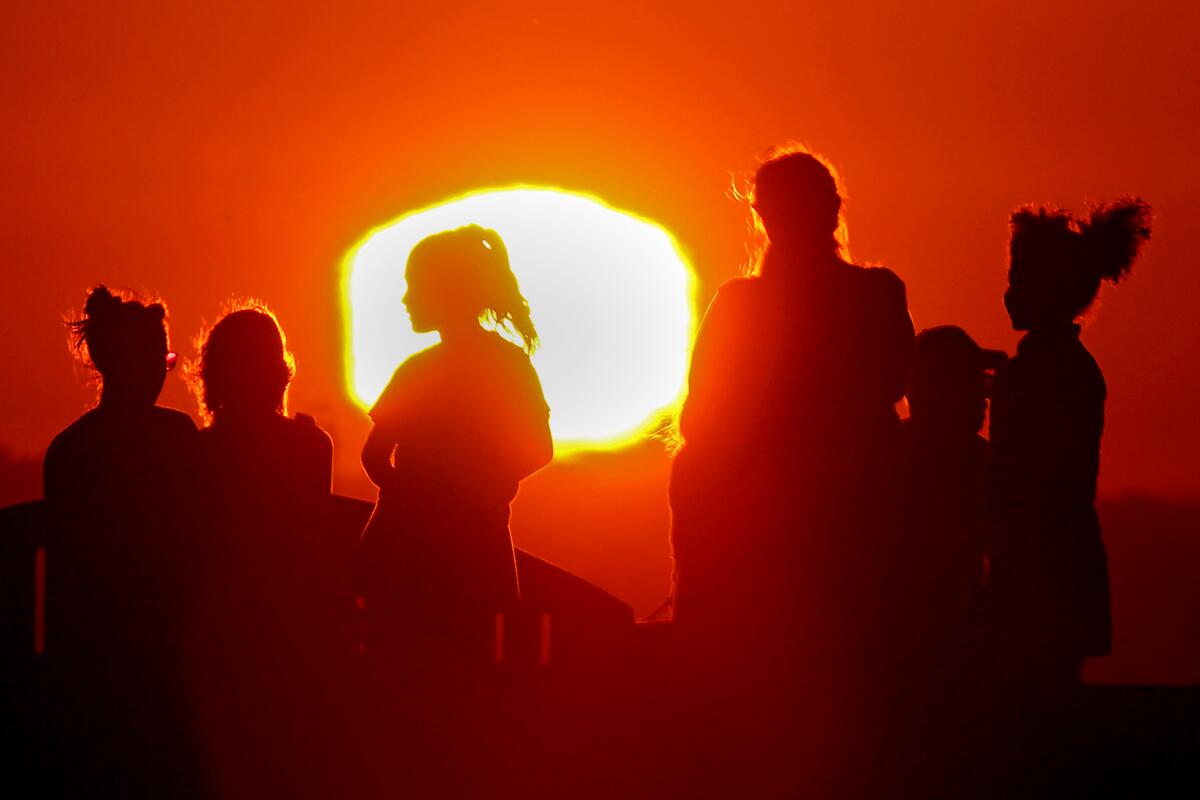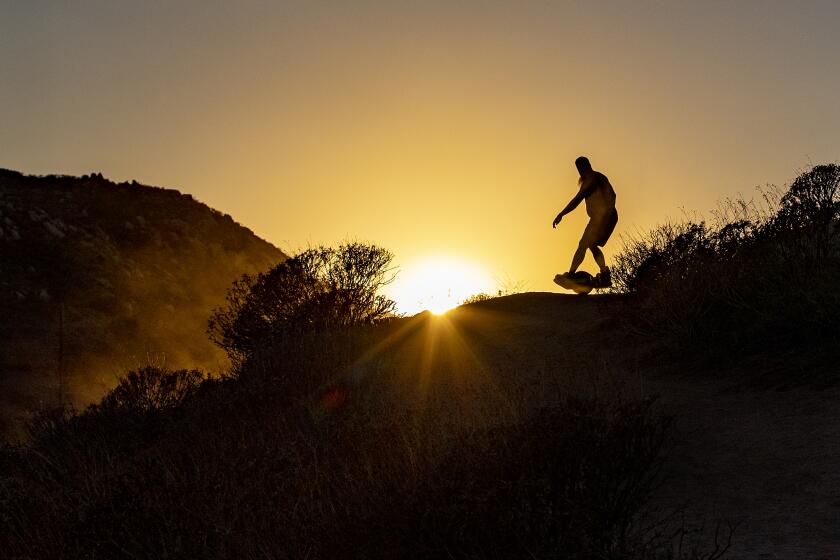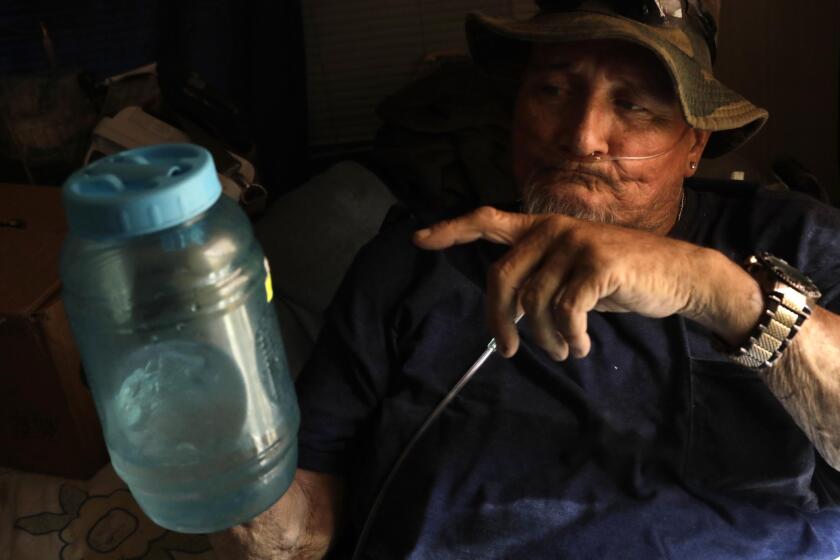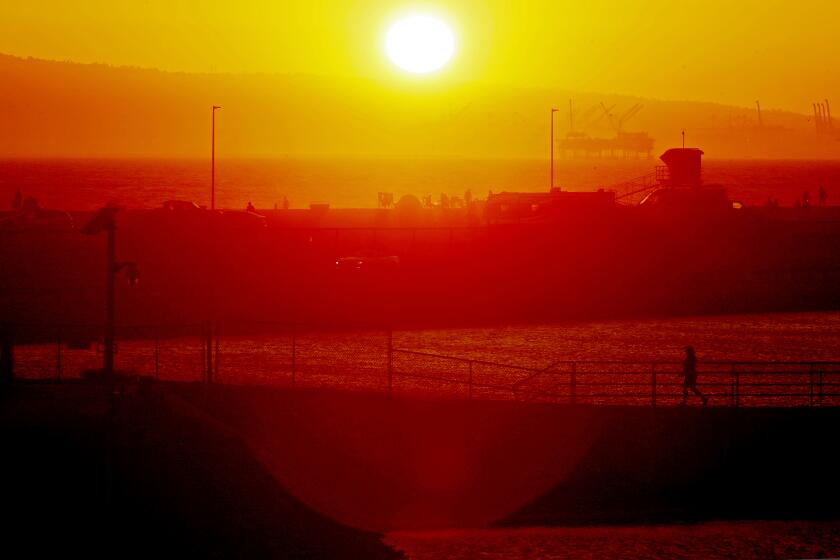How to stay cool and safe during California’s first heat wave of the summer

- Share via
The next few days in Southern California will be very, very hot.
The first heat wave of the summer will start to bear down on much of the Golden State on Friday and may continue into the following week. The National Weather Service said places such as Palmdale and Bakersfield might see 105-degree temperatures, and Los Angeles County’s valleys could experience 100 degrees by Saturday.
And it’s just the start of what is anticipated to be a sweltering summer. The National Oceanic and Atmospheric Administration predicts that weather in July and August will be warmer than usual.
‘Any spark from fireworks could easily start a fire in the tall grass crop that has cured and turned brown in recent weeks,’ the weather service says.
More people die and visit emergency rooms during hot weather, and there’s a heightened risk for heat-related illnesses such as heatstroke and heat exhaustion. Pets, children, the elderly, pregnant people, people who work outside and those with chronic health conditions such as asthma and diabetes are especially vulnerable.
Los Angeles officials recently launched the “Heat Relief 4 L.A.” campaign in an effort to protect residents from the health impacts of extreme heat waves.
“We want to make sure people understand that this is not our grandparents’ L.A. summer anymore,” said Marta Segura, the city’s chief heat officer. “These heat waves are longer, hotter, more frequent and a lot more dangerous as the climate crisis has accelerated. So we wanted [residents] to be prepared and plan ahead and work together to protect one another from these really fatal, risky heat incidents.”
Below are some tips on how to stay cool and safe during a heat wave:
Avoid the outdoors (if possible)
Dr. Fausto Farfan’s No. 1 tip for how to stay cool and safe during hot days is to stay clear from heat for prolonged periods. “If you can avoid being outdoors when it’s hot, that’s going to be the best way to avoid heat illness,” he said.
If you have to be outside, schedule outdoor activities for early in the morning or late in the evening when temperatures are lower. Staying hydrated will be critical for people who have to be outdoors, said Farfan, chief of emergency services at Kaiser Permanente Woodland Hills Medical Center.
Segura also urged employers to consider changing outdoor workers’ schedules to avoid the hottest times of the day, and to ensure they’re getting sufficient water and more breaks in the shade.
But if you plan to hit the beach this weekend or for the Fourth of July, take an umbrella or tent so you have shade, and make sure you’re applying enough sunscreen. “If you start getting sunburned, your body has a harder time regulating your body temperature, so you want to avoid getting significant sunburns,” said Farfan.
Taking a dip in the ocean can also help if you feel you’re overheating.
Read all of our coverage about how California is neglecting the climate threat posed by extreme heat.
Don’t have an A/C unit at home? Find a cooling center
The city of Los Angeles created an app to help Angelenos find relief during heat waves.
Cool Spots LA is an interactive directory of public spaces across the city where people can cool off, including pools, splash pads, libraries, senior and recreation centers, bus shelters, shade structures and hydration stations. Just input a location in the search box and select a distance area of up to five miles. A map will identify your options. Click on an icon on the map for information about the cool spots near you.
Cooling centers include more than 70 branches of the L.A. City Public Library System. Libraries without on-site hydration stations are offering patrons bottled water during the heat wave, said Emily Lenhart Fate, assistant branch library director.
Activities, water and in some cases food will be offered to visitors at augmented cooling spots such as community centers and parks and recreation facilities, Segura said.
When parks and recreation spaces are activated as cooling centers, pets are welcome there, but dogs must be on a leash and animals must not be left unsupervised. Kennels are available upon request.
If you live outside city limits, L.A. County has its own list and interactive map of cooling centers. Museums, shopping malls and movie theaters are also fun and good places to stay cool.
The National Oceanic and Atmospheric Administration predicts that California temperatures in June, July and August will be warmer than normal.
Stay hydrated
Drinking more water than you’re used to, and drinking it before you’re thirsty, will help keep you hydrated, Farfan said. If you’re outdoors and sweating, the standard is to drink two to four cups of water, or about 16 to 32 ounces of fluid, every hour.
He also suggested adding electrolytes to water or drinking sports drinks to help your body replenish the salt and minerals you lose from sweating.
One way to tell if you’re sufficiently hydrated is to pay attention to your pee. Urine that’s dark yellow or even brownish is a sign that you need to drink more fluids. “Usually, the rule of thumb is that if you’re staying well-hydrated, your urine should be a light yellow color,” he said. And if you’re urinating less than you’re used to, it’s probably time to drink up.
Know the signs and symptoms of heat-related illness
Heat-related illnesses can range from sunburns and heat rashes to more dangerous conditions such as heat exhaustion and heatstroke, according to the U.S. Centers for Disease Control and Prevention.
Signs of heatstroke, the most serious of them all, include a body temperature of 103 degrees or higher; a fast, strong heart pulse; hot, red, dry or damp skin; headache; dizziness; nausea; confusion; and passing out. If you or someone you know is experiencing these symptoms, seek medical attention right away. In the meantime, the CDC says to move to a cooler place and to lower your body temperature with cool cloths or a cool bath, but don’t drink anything.
According to the CDC, signs for heat exhaustion include heavy sweating; cold, pale and clammy skin; a fast, weak heart pulse; nausea or vomiting; muscle cramps; tiredness or weakness; dizziness; headache; and passing out. If you have these symptoms, move to a cool area; loosen your clothes; put cool, wet clothes on your body or take a cool shower; and sip water.
Get medical help right away if you’re throwing up, your symptoms get worse, or if they last for more than an hour.
An excessive heat watch is in place for much of Southern California this week. Keep yourself, your kids and your pets safe during hot temperatures with these tips.
Protect the most vulnerable
Children, pets, the elderly, unhoused residents, pregnant people and people with chronic health conditions are more vulnerable to heat-related illnesses.
Farfan said they’ll mostly require the same safeguards as everyone else, but it’s important to check in on them, “sort of like a buddy system to keep an eye on them in case they don’t realize that they’re starting to overheat.”
If you notice that they’re flushed, sweating excessively, are having a harder time moving around, or are exhibiting other symptoms of heat-related illnesses, get them some water and help them move to a cooler place.
And never leave a child or pet in a car — temperatures can quickly skyrocket even with windows cracked.
Stay informed
Angelenos can sign up for extreme heat alerts through the city’s website. You can also check your area’s forecast on the National Weather Service’s website, and find weather watches, warnings and advisories for California and beyond on NOAA’s site.
Others tips for staying cool
- Eat foods with high-water content such as watermelon and cucumbers, but limit or avoid sugary, alcoholic and caffeinated drinks.
- Wear loose, light-colored clothing and hats for protection.
- Keep your pets indoors if possible. If you have to keep them outside, make sure they have plenty of shade and water.
- Take a cold shower.
- If possible, avoid using your stove, oven or other appliances that generate heat.
Times staff writer Hayley Smith contributed to this report.
More to Read
Sign up for Essential California
The most important California stories and recommendations in your inbox every morning.
You may occasionally receive promotional content from the Los Angeles Times.















